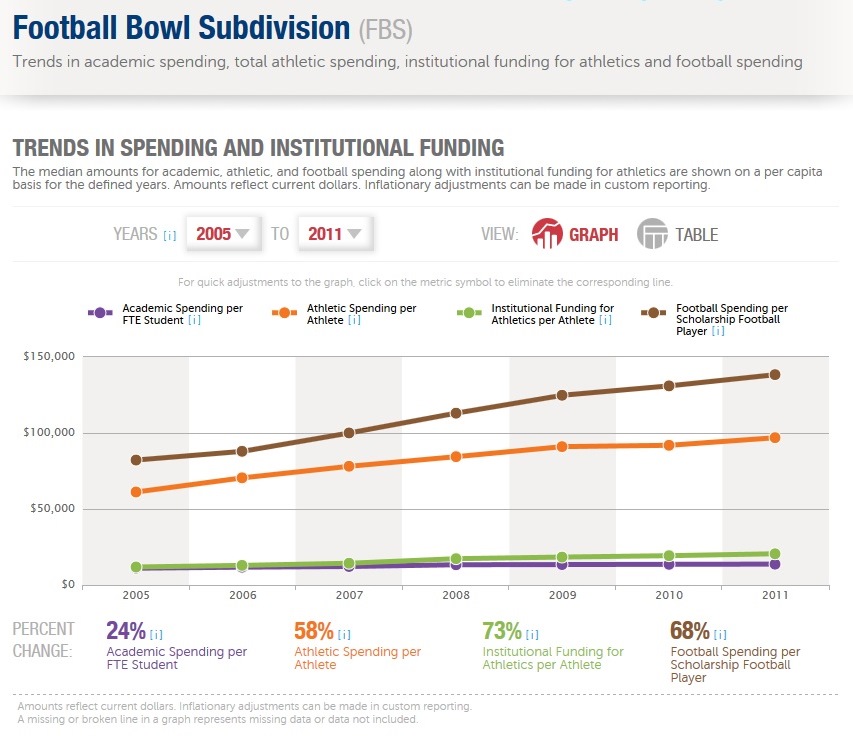You have /5 articles left.
Sign up for a free account or log in.
Wondering how much more your college's sports program spends per athlete than your institution does in academic funds per student? What your university spends on coaching salaries per player? What your campus pays to subsidize its sports program out of institutional funds?
Then the Knight Commission on Intercollegiate Athletics has the database for you.
The commission, which next year will mark 25 years since issuing its first report on college sports reform, is today releasing a database designed to provide campus officials, policy makers, reporters and others with better -- and more accessible -- statistical information about how colleges in the National Collegiate Athletic Association's Division I finance their sports programs. It does so by marrying data from several existing sources in a unique way.
The data on sports revenues and expenditures come from USA Today's groundbreaking college sports finances database, which has been available for several years and is based on colleges' own reports to the NCAA. The association itself does not make these data public, and USA Today's database includes only those institutions (all public) that have acceded to the newspaper's requests for the information.
Many private universities (including Duke, Northwestern and Stanford Universities and the University of Southern California) and a handful of public institutions (such as Temple University and the University of Pittsburgh) that are exempt from state open records laws are missing from the Knight database as a result. (Knight officials say that they will welcome the participation of any such colleges that want their information to be included, but even the private institutions whose presidents are on the Knight panel -- R. Gerald Turner of Southern Methodist University, John J. DeGoia of Georgetown University -- are not participating in the commission's financial database.)
The Knight database merges those sports budget data with information on athletic participation that is drawn from colleges' reports to the U.S. Department of Education under the Equity in Athletics Disclosure Act, which collects information on gender discrimination under Title IX of the Education Amendments of 1972.
Those athletics data are then combined with statistics on academic and instructional spending from the American Institutes of Research's Delta Cost Project, which refines data from the federal government's Integrated Postsecondary Education Data System.
The result allows users to compare athletic and academic spending at any combination of Division I institutions and to customize analyses depending on their interests. The Knight Commission argued in a 2010 report that making more accurate and comparable financial data about college sports publicly accessible was important in trying to redress an imbalance -- laid out in the report -- in which spending on athletics was growing at a significantly faster clip than institutional spending over all, and especially on instruction.
“We already see levels of spending at some universities that require them to divert substantial resources from their core academic responsibilities," William E. (Brit) Kirwan, chancellor of the University System of Maryland and, with SMU's Turner, co-chairman of the commission, said in a news release about the database. "We are hopeful this online database will help university leaders and policy makers develop practices and policies that bring better balance to athletic expenditures within the broader institutional missions.” (Kirwan knows what he's talking about: his system's flagship institution, the University of Maryland at College Park, is leaving its longtime home in the Atlantic Coast Conference for the Big Ten Conference, in pursuit of greater visibility and much larger television dollars, a year after it cut numerous teams to lessen a major sports deficit.)
- From 2005-2011, in every Division I subdivision, athletic spending per athlete grew at a faster rate than academic spending per student.
- During that same period, academic spending per student at institutions that compete in the NCAA's top competitive level, the Football Bowl Subdivision, rose by 3 percent after adjusting for inflation, while athletic spending per athlete increased 31 percent and football spending per football player grew 52 percent -- excluding spending on athletic scholarships.
- From 2005-2011, the growth in institutional support for athletics per athlete was greater than the growth in academic spending per student.






